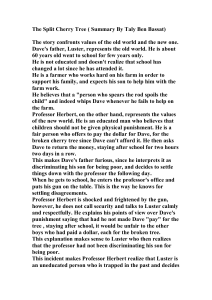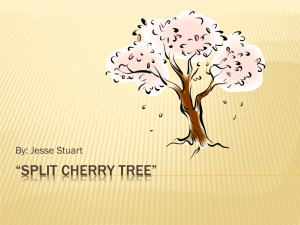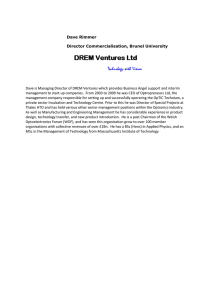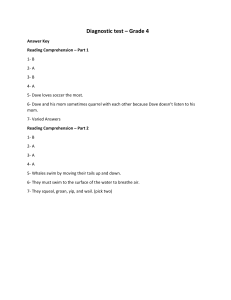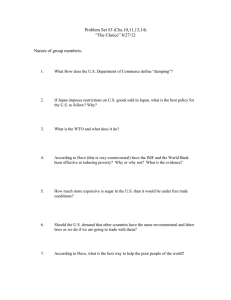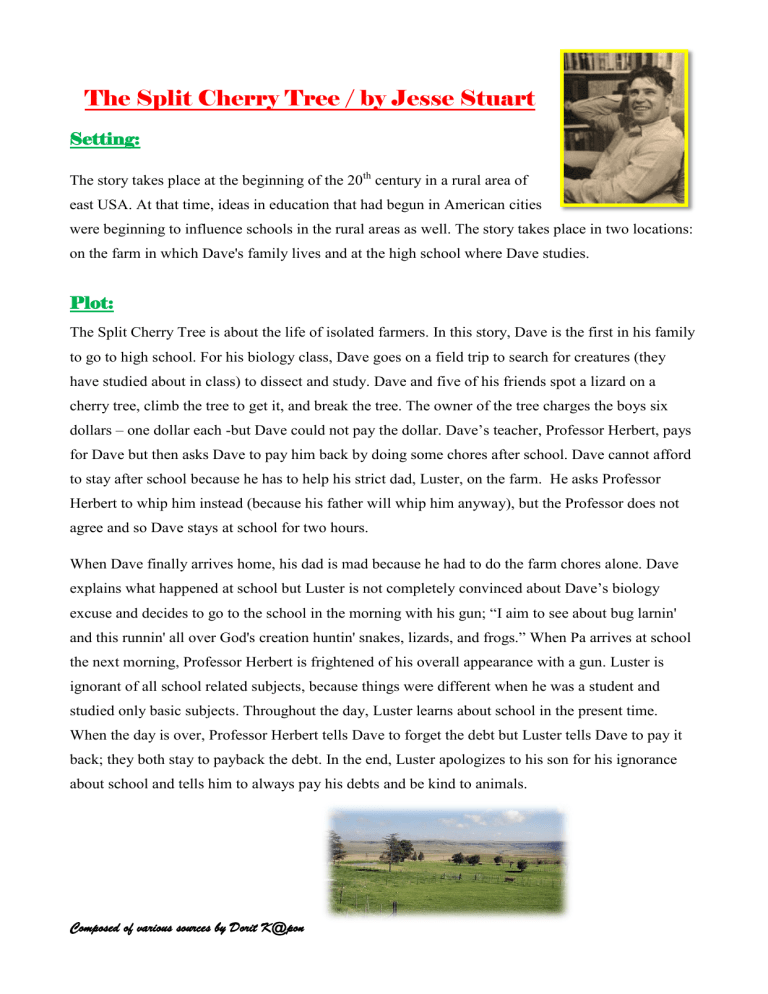
The Split Cherry Tree / by Jesse Stuart Setting: The story takes place at the beginning of the 20th century in a rural area of east USA. At that time, ideas in education that had begun in American cities were beginning to influence schools in the rural areas as well. The story takes place in two locations: on the farm in which Dave's family lives and at the high school where Dave studies. Plot: The Split Cherry Tree is about the life of isolated farmers. In this story, Dave is the first in his family to go to high school. For his biology class, Dave goes on a field trip to search for creatures (they have studied about in class) to dissect and study. Dave and five of his friends spot a lizard on a cherry tree, climb the tree to get it, and break the tree. The owner of the tree charges the boys six dollars – one dollar each -but Dave could not pay the dollar. Dave’s teacher, Professor Herbert, pays for Dave but then asks Dave to pay him back by doing some chores after school. Dave cannot afford to stay after school because he has to help his strict dad, Luster, on the farm. He asks Professor Herbert to whip him instead (because his father will whip him anyway), but the Professor does not agree and so Dave stays at school for two hours. When Dave finally arrives home, his dad is mad because he had to do the farm chores alone. Dave explains what happened at school but Luster is not completely convinced about Dave’s biology excuse and decides to go to the school in the morning with his gun; “I aim to see about bug larnin' and this runnin' all over God's creation huntin' snakes, lizards, and frogs.” When Pa arrives at school the next morning, Professor Herbert is frightened of his overall appearance with a gun. Luster is ignorant of all school related subjects, because things were different when he was a student and studied only basic subjects. Throughout the day, Luster learns about school in the present time. When the day is over, Professor Herbert tells Dave to forget the debt but Luster tells Dave to pay it back; they both stay to payback the debt. In the end, Luster apologizes to his son for his ignorance about school and tells him to always pay his debts and be kind to animals. Composed of various sources by Dorit K@pon Characters: There are three main characters in the story: Pa, Dave and Professor Herbert. Pa, Dave's father, is a hard, uneducated man with firm beliefs. When Pa speaks, his language is poor, unclear and incorrect. At the beginning, he is stubborn and narrow-minded about his beliefs on traditional education. He is very strict with Dave and threatens to whip him for being late. He believes that his children must listen to him – "If you spare the rod, you spoil the child". He is big and rough, and wears overalls and boots to go to the school. Pa believes that solving problems with physical force or violence is the best. He would rather Professor Herbert whipped Dave. Pa doesn’t understand the punishment that Dave and his friends have got; he thinks that they should be punished physically. In the beginning, Pa wants to use his gun. He believes in immediate results and wants to see the results promptly. (It’s possible that Pa was raised this way when he was young). Despite his strict personality, Pa educates Dave to be honest to people and nice to animals. At the end, however, he realizes that the world has changed and that he is old-fashioned. When Professor Herbert introduces him to biology, he accepts the fact that there is a need of new education. We learn that he is honest and kind to animals that are weaker than him. He understands the justice of the punishment and helps Dave to carry it out. He shows that he can change and is open to new ideas and methods. He wants his son to have a better education than he had. Dave is torn between the educated and the uneducated (between traditionalism and modernism). After school he helps Pa on the farm and then does his homework. Dave represents the younger generation who is supposedly adopting the modern worldview. He is bridge between traditionalism and modernism. He respects his father and is proud of him most of the time, but also knows that he’s oldfashioned and unable to understand what he’s learning. Professor Herbert is the educated person who teaches biology. When Professor Herbert speaks, his English is clear and correct. Professor Herbert doesn’t live in the rural area and doesn’t realize how hard life on a poor farm is. He represents modern education (he takes his students on a field trip so they can have a hands-on learning experience and he tries to be fair when he punishes the boys). Composed of various sources by Dorit K@pon the Themes: Traditionalism vs. Modernism - the inevitability ( )אי יכולתנו למנועof change and our reaction to it - acceptance vs. resistance. The generation gap - The father and son may have been part of the same family but also belong to a different period of time. Literary terms: Conflict - Conflict is the struggle between opposing forces. In the story we see the conflict between two opposing worldviews – traditionalism and modernism. The story introduces conflicts between the rich and the poor as well as the educated and uneducated as Dave’s father confronts the schoolteacher. The central conflict of the story arises, because Dave does not have the money to pay for the tree that he and his friends broke. The presence of Luster’s gun adds tension to the scene as he enters into an argument with Professor Herbert over the nature of education. Luster does not understand “all this bug larnin’, frog larnin’, and findin’ germs on your teeth”, and he neither understands nor likes that the boys and girls are allowed to go on field trips together. What he does understand, is that a bullet “will kill a schoolteacher same as it will any other man. It will kill a rich man same as a poor man”. Guns, to Luster, represent equality. A bullet does not care about age, education, class; it kills indiscriminately. Point of view - The story is told from Dave’s point of view (first person). Climax - This is the point of highest interest, the crisis, and is therefore also at the turning point of the action, since from this point on all conflicts will be solved. The climax of the story takes place when Luster looks through the microscope and sees the germs. As a result, he gains some faith in school. He realizes that he has been wrong. The world has changed. He understands that his belief in "Seeing is Believing" has been shuttered. Thus, when Professor Herbert wants to dissect a black snake to show Pa that germs exist in their bodies too, Pa refuses and asks Professor Herbert not to kill the black snake. After seeing the germs Pa believes the Professor. Resolution- The conclusion of the story or drama, when all the problems are solved in one way or another. It's the logical outcome of everything that happened before. Luster admits school has changed and wants Dave to continue attending school in order to have a better future. Composed of various sources by Dorit K@pon The message: It is impossible to fight change because the world moves on, and we must move with it or be left behind. Modernism is stronger than traditionalism. Yet traditional values still exist and shouldn’t be ignored or forgotten. Luster shares two very important pieces of information with Professor Herbert. The first is that he never kills black snakes because they are good mousers and he does not want to see Professor Herbert kill and dissect one. He also does not harm cattle and mules because unlike people, they can't defend themselves. Professor Herbert, after his day talking with Luster begins to understand the life of a family in the hills and wants to forgive Dave’s debt so he can go home to work. Luster, however, insists on helping Dave clean so his debt will be fully paid and claims that he never skips debts. After a day spent together, Luster has been shown the importance of a book education and Professor Herbert has been shown the importance of a life education. Analysis and interpretation: The story is based on dialogues between the characters. Dave’s English is clear and good most of the time. Each character speaks in a way that reflects his level of education. Pa uses a lot of slang and words that are specific to the poor area. His speech shows the lack of education. Unlike him, Professor Herbert speaks politely. Pa represents the traditional worldview (traditionalism) and Professor Herbert represents the modern worldview (modernism). Pa has old-fashioned ideas about education and discipline. On the contrary, Professor Herbert doesn’t believe in whipping pupils and takes his class on field trips where he illustrates to them the subject of biology. Professor Herbert shows Luster the germs on his teeth through a microscope, teaches him about the new education Luster had been so dismissive of, teaching both Luster and Dave something in the process. Luster learns not only about germs and dissection, but he learns that his time for learning has passed, and he must trust Professor Herbert to Composed of various sources by Dorit K@pon lead his son’s generation. Thus, the conflict between traditionalism and modernism is resolved when Pa joins Professor Herbert on a tour in school. Pa realizes that the world had changed while he was raising a family and making a living. Traditional education is out of date. The author of the story shows this through Pa’s eyes because Pa understands this during the tour in school. Dave, too, learns something from this interaction. Previously, when hoping his father would not go to Dave’s high school with a gun, Dave had considered telling his father that school had changed “from the way it was when he was a boy” but figured he would not understand. Yet, Luster’s encounter with Professor Herbert clearly shows that Dave’s father was not only willing, but eager to listen and learn new things. Professor Herbert, after his day talking with Luster begins to understand the life of a family. Knowledge is the victor in the multiple conflicts that arise throughout the story whether the knowledge is imparted by a teacher or a farmer; regarding biology and dissection or how to humanely treat animals. The delivery is also significant; Professor Herbert shows Luster through a microscope the germs on his teeth; Luster shows Professor Herbert family pride by helping his son sweep. There are no condescending lectures, no shouting, all these lessons are taught by example, which allows them to be a powerful force for mediation and learning rather than intensifying the conflict. Composed of various sources by Dorit K@pon
